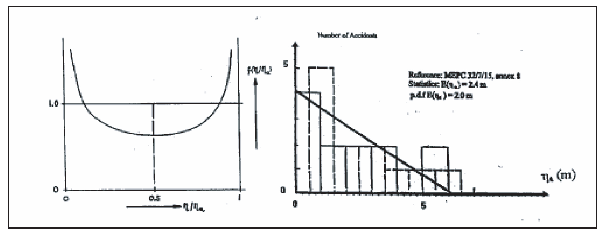7.1 For bottom damage, oil loss is calculated
based on the pressure balance principle.
7.2 In accordance with paragraph 7 of regulation 23, for a given tidal
condition the mean outflow from bottom damage is calculated as follows:
7.3 As explained below, the factor CDB(i) accounts
for oil entrapped within non-cargo tanks located immediately below
a cargo tank.
7.4 Independent calculations are carried out for
zero and minus 2.5 m tide conditions and the outflow values are then
combined as follows:
7.5 Tidal Effects
-
7.5.1 When an oil tanker experiences bottom damage
as a result of a stranding and remains aground, the occurrence of
a fall of tide may result in an outflow of oil because of the hydrostatic
balance principle. For this regulation, oil loss is calculated assuming
tide reductions of 0 and 2.5 metres.
-
7.5.2 The random nature of the fall of tide may
be described by the following two probability density functions:
-
.1 probability density function of relative fall
of tide assuming that the tidal motion may be represented with sufficient
accuracy by a long-periodical harmonic motion and that the time dependent
probability of occurrence of a grounding accident is uniformly distributed
over the tidal period. The relative fall of tide is defined as the
ratio of the actual fall of tide and the double amplitude of the tidal
motion.
-
.2 probability density function of the double
amplitude of tidal motion at the time of the accident. From the statistics,
which are restricted to data available from the OTD study [1], an
approximate analytical description of the probability density function
can be estimated.
-
7.5.3 From these two probability density functions
the probability density function of the actual fall of tide may be
derived. Although extreme tides of 6 m or more occur in certain areas
of the world, such large tides are relatively rare. The probability
density function for the fall of tide shows a significant effect up
to about 3 m. That is, the probability of an actual fall in tide in
excess of 3 m is less than 5%.
-
7.5.4 There is also a reduced probability that
vessels will ground at high tide, as under keel clearances are typically
increased.
-
7.5.5 It was determined that the tidal effect
could be reasonably represented by performing calculations at two
tides, 0 m and -2.5 m and then combining the results by 70%:30% ratio.

Histogram and Probability Density Function: Fall of Tide
7.6 Cargo tanks bound by the bottom shell
-
7.6.1 Even if they are in hydrostatic balance,
some cargo oil outflow can be expected from cargo tanks bounding the
bottom shell which are penetrated due to bottom damage. These losses
are attributable to initial exchange losses occurring on impact, and
dynamic effects introduced from current and waves.
-
7.6.2 For the OTD study (1)
footnote, model tests were carried out for the
purpose of assessing the magnitude of these dynamic losses. For the
purposes of that study, it was decided that oil outflow equal to at
least 1% of the cargo tank volume should be assumed. This same assumption
is applied in the Revised Interim Guidelines as well as regulation 23.
7.7 Oil retained in non-oil tanks located below
the cargo tank
-
7.7.1 When a double hull tanker experiences bottom
damage through the double bottom tanks and into the cargo tanks, a
certain portion of the oil outflow from the cargo tanks may be entrapped
in the double bottom tanks. Where the pressure differential between
the cargo in the tank and the outside sea is small (e.g. during a
falling tide), it is reasonable to assume that the double hull space
will be very effective in retaining lost oil. However, when the pressure
differential is relatively large and the penetration small, model
tests conducted during the OTD study (1)
footnote demonstrated that only about 1/7 of the
oil flowing out was retained in the double hull spaces.
-
7.7.2 As a consequence of these studies, it was
surmised that "if both outer and inner bottoms are breached simultaneously
and the extent of rupture at both bottoms is the same, it is probable
that the amount of seawater and oil flowing into the double hull space
would be the same." On this basis, the Revised Interim Guidelines
specify that for breached non-cargo spaces located wholly or in part
below breached cargo oil tanks, the flooded volume of these spaces
at equilibrium should be assumed to contain 50% oil and 50% seawater
by volume, unless proven otherwise.
-
7.7.3 With the simplified approach applied in regulation 23, the combination
of tanks involved in each damage scenario is not determined and therefore
oil retention in non-cargo spaces cannot be directly computed. To
account for oil retention in this regulation, the oil outflow from
a cargo tank located above a non-cargo space as determined from the
hydrostatic balance calculation is multiplied by an outflow reduction
factor CDB(i).
-
7.7.4 To determine the outflow factor CDB(i),
bottom damage outflows for ten actual double tankers as well as the
parametric series of designs discussed in paragraph 8 were calculated
with and without double bottom retention. The outflow reduction factor
fell between 0.50 and 0.70 for all of the actual tankers, and 83%
of the designs in the parametric series. On this basis, an outflow
reduction factor CDB(i) of 0.60 was selected. That is,
(1 - 0.60) or 40% of the outflow is assumed to be entrapped by the
non-oil tanks below.